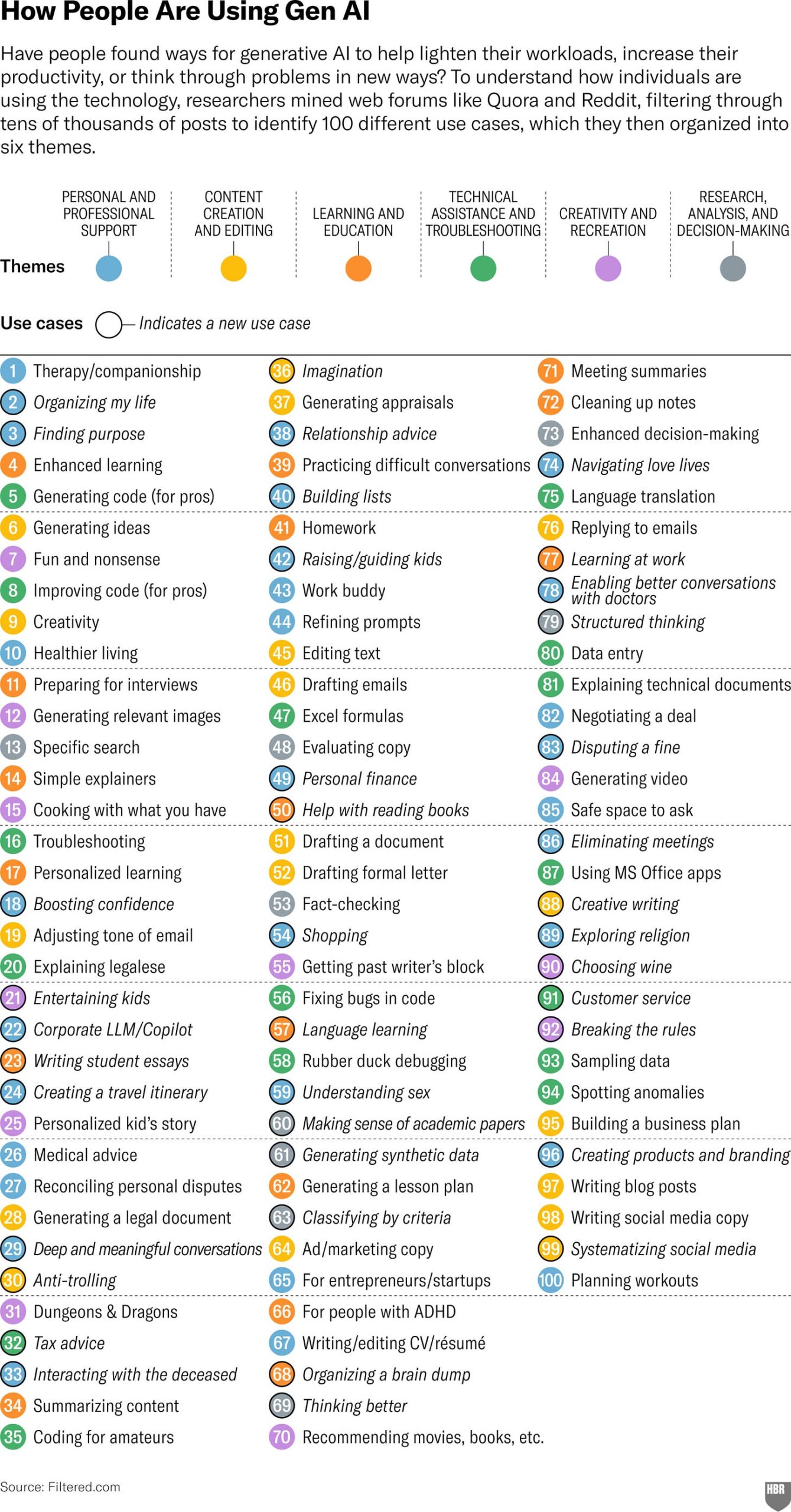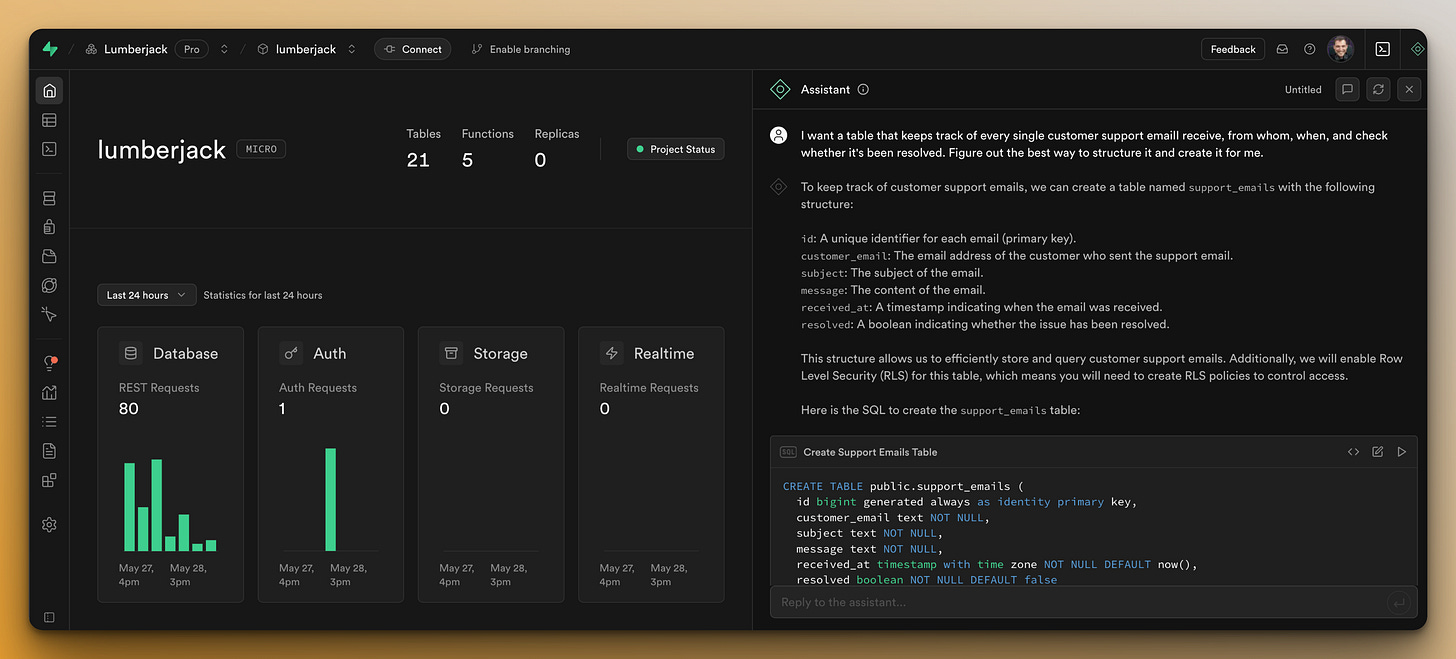
These days I talk a lot about becoming an AI-First Operator. I work with non-technical founders every week to empower them, to free up their calendars and their minds.
That’s what most of us are expecting from AI anyway. To take over the shitty part of our work, managing our lives. If you look at the recent HBR study, you’ll see that “organizing my life” is number two on the list of how people use Gen AI.
I already talked about number one use case, which is companionship here:
How to organize your life with AI
AI tools are getting better and better every week. You want something that gets better with a model upgrade, not worse. Otherwise you’ll introduce tech debt in your personal life. It feels like frustration.
Getting frustrated with all sorts of tools, software and technology. Instead of getting clarity, most of these chatbots are just adding to that frustration. If you want to become more productive, free up your mind and your schedule, read on.
I’ll give you a sneak peek into what you can learn on the AI-First Operator Bootcamp.
Step 1: Pick an interface
Forget about ChatGPT. It’s too closed, it won’t let you customize it to your needs. The reason why AI has been letting you down is because it lacks context of you.
Instead of you going to AI, you want the AI to come to you.
Option A: Slack
I’ve set up an Alfred instance as a Slack bot. It’s powered by a simple n8n workflow. Every time I tag Alfred in a message, the workflow runs, making use of n8n’s AI Agent node with MCP. What I see is this:
But what happens in the background is this:
If I want to, I can easily add more capabilities to it, change the model, modify its memory, etc. The point is that since I’m running my solo business and manage our lives via Slack, it makes more sense for Alfred to be where I am and not the other way around.
n8n also allows me to use its nodes as MCP tools which is a big thing if you know what you want. But sometimes, you want a more generic assistant that doesn’t need handholding.
Option B: Claude Desktop
I’m a big fan of Claude Desktop. It does limit my operations to my desktop but I can make good use of Claude’s capabilities, including: agentic reasoning, artifact generation, automatic model upgrades.
It’s really useful when you’re not exactly sure you set things up the right way.
For example, I configured Claude Desktop with an MCP server to connect to my revenue data. I asked a simple question and Claude made a mistake that resulted in an error. Then it kept going until it corrected itself.
This is the kind of agentic behavior you want to see. A sort of scaffolded agency. That means AI is agentic but only within the boundaries you set it.
If I did the same within Slack, its ability to self correct would be entirely determined by the model, nothing else. If I plug o3 into my Slack bot, it will handle errors more graciously than if I plug o1 in it.
But Claude Desktop has a big advantage: I can easily install MCP servers via Smithery. The good thing is that instead of me having to add every single action as a separate tool (like in the n8n example above) I can just add one MCP server and that adds all tools and resources.
Option C: Custom voice agent
If you purchased AlfredOS you’ll get one, with voice capabilities in a few months. If you purchase an Operator Pass or a VIP Pass you’ll get it too. The problem here is that when you use a custom agent, you’re completely limited by its capabilities.
This is the ultimate user experience which OpenAI has been trying to capture for a while. Anthropic is also jumping on the voice agent train:
Step 2: Install MCP Servers
My favorite resource for MCP servers is Smithery. It allows really easy install of MCP server for a growing number of clients. I’ll show you now how to install a n8n MCP server for Claude Desktop.
Once I found the relevant server, I selected my client (Claude Desktop) → Smithery gave me a terminal command.
This is what the terminal command looks like:
npx -y @smithery/cli@latest install @guinness77/n8n-mcp-server --client claude --key [redacted]
I redacted the key I got from Smithery, but all you need to do is run this locally in your terminal. Just copy and paste. Terminal can get scary I know, but if all you gotta do is copy/paste, it’s manageable.
That’s it. Claude Desktop restarts and when you go to Settings →Developer you’ll see the configured MCP servers. From now on, when you prompt Claude it will recognize the available tools and fetch the relevant context automatically.
Step 3: Minimum Viable Workflows
Once you have your agent what you’ll need to do is pick what I call your minimum viable workflows. This is when AI goes from exciting to useful.
What eats up most of your time? Think about it. Probably not what you’d first think of.
-
Creating proposals for your clients?
-
Processing meeting memos into tasks?
-
Finding new leads?
-
Onboarding clients?
-
Keeping track of utility bills?
For me, my biggest pain is keeping track of all the transactions and actually getting on top of my business. I’m very disorganized. People pay me via Stripe, Polar, Gumroad and it gets messy very quickly.
So I created a super simple workflow that organizes everything for me.
You probably noticed that Supabase logo popping up a few times already. That’s our Step 4, a centralized database.
That’s when individual workflows (that are just automations not agents) feed into our AI system and everything comes together into one big beautiful soup of data.
Step 4: Your Database
I love Supabase. It’s a bit technical, but it has a built in AI assistant that will manage everything for me. Let’s say I want to keep track of customer support tickets. I need to store that somewhere. So first, I’ll create a new table…well…use AI to do it for me:
Your new, AI-first reality
Then I can not only run the exact SQL code by clicking a simple ▶️ icon and copypaste it over to Claude Desktop with a n8n MCP server plugged in to design the n8n workflow for me.
You only need surface level understanding of n8n to create this workflow, because Claude will be there with you, all you need to have is what one of my readers called conversational dexterity.
The reason why you want everything inside a single database (even if it’s Airtable, Supabase or whatever) is because you can use a SINGLE MCP server to access any and all data you might want.
Join the Bootcamp before it’s late
Excel forced us into spreadsheets.
SaaS moved us onto dashboards.
It’s time you let AI meet you where you are.
It’s time for you to become an AI-First Operator. Click here.










